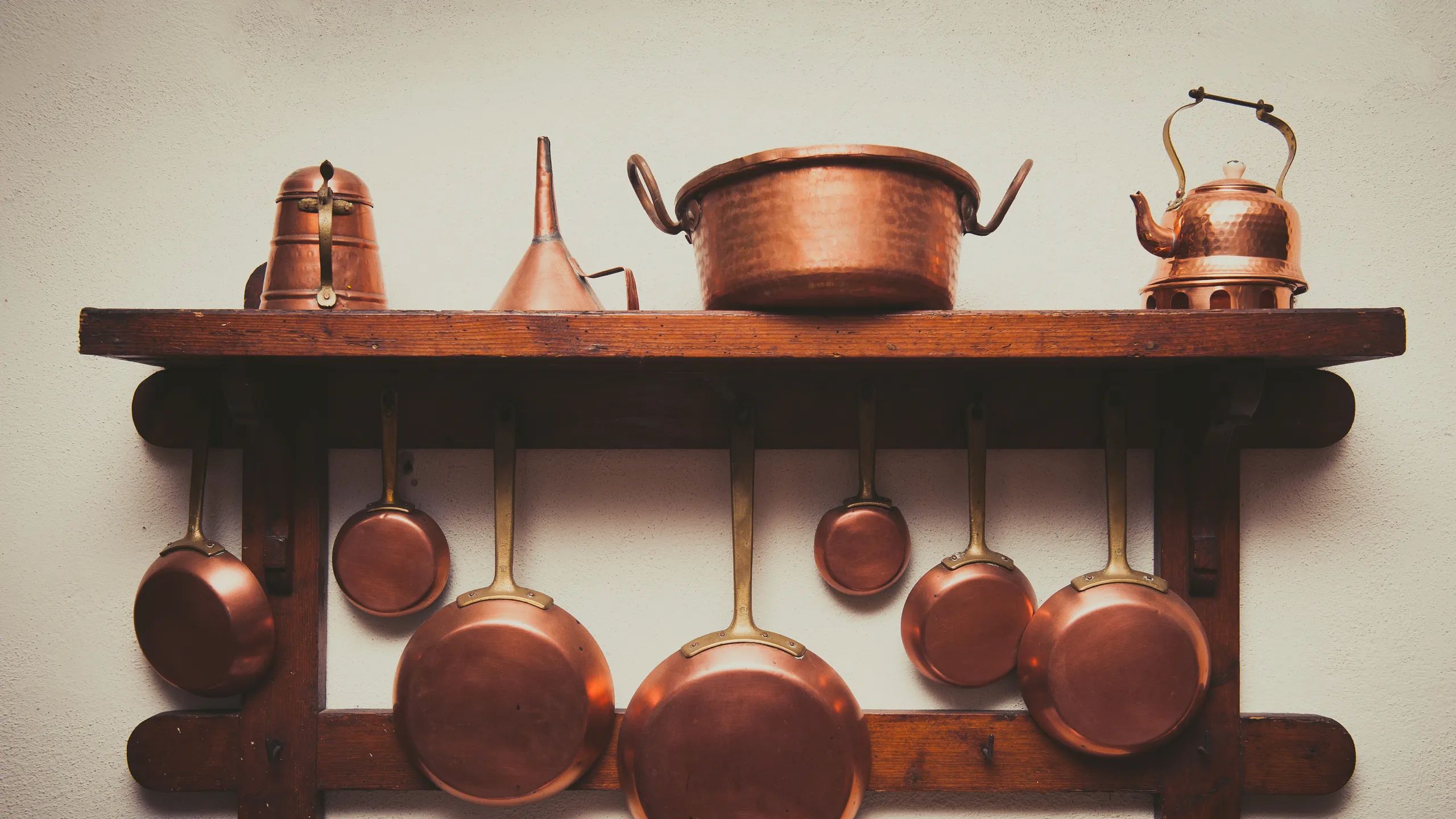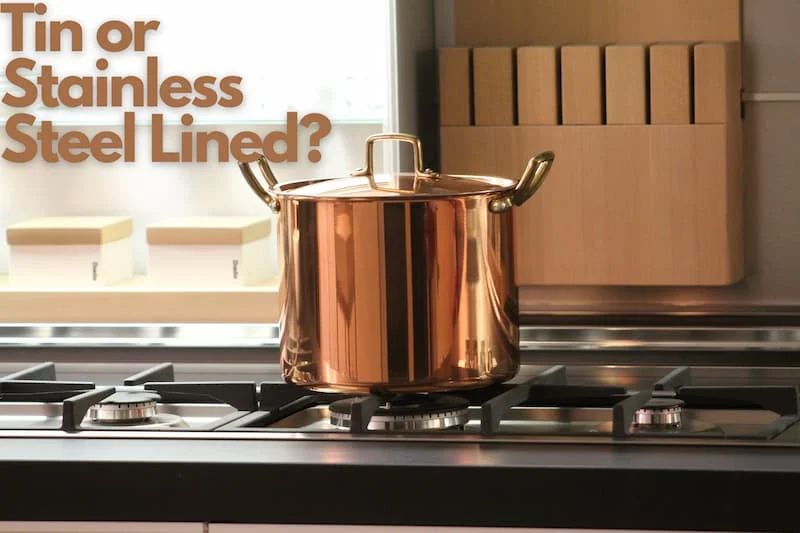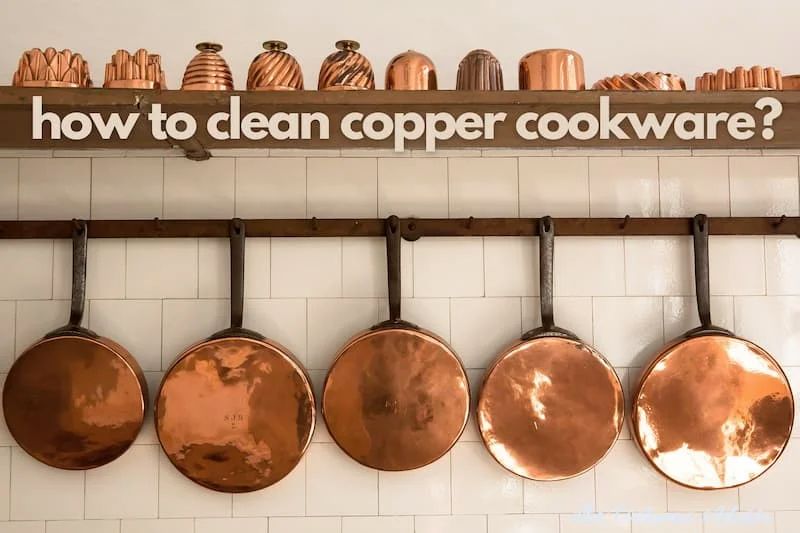• Cast Iron
Copper Cookware: 11 Burning Questions Answered!

Reviewed by Trinity Anderson
Last Updated December 2023

A Definitive Guide to Copper Cookware
During a recent visit to a chocolate factory that specializes in hand-made, gourmet chocolates, I had the opportunity to take a guided tour. As I indulged in the complimentary samples, I couldn't help but notice something peculiar.

The lady operating the machinery was stirring melted chocolate in an unlined copper drum. This immediately raised concerns in my mind about the potential dangers associated with this practice, especially considering the amount of chocolate I had consumed.
Curiosity got the better of me, and I decided to inquire about this unusual choice of material. However, the tour guide simply smiled, shook her head, and continued with her presentation. This only served to further pique my interest.
The following day, one of my readers reached out via email, seeking advice on re-tinning her copper pans and whether or not tin lining is safe. This left me wondering if people still engage in such practices.
It became apparent that there was a great deal I didn't know about copper cookware. All I knew was that I needed to gain a comprehensive understanding of its safety, quality, and the necessity of lining it with tin or alternative materials.
As a result, I have compiled the most comprehensive guide to copper cookware that you will ever need.
1. Why use Copper cookware?
Copper cookware is renowned for its exceptional performance and exquisite appearance. It surpasses all other pots and pans, making it the Rolls-Royce of the culinary world. Its aesthetic appeal is matched by its unparalleled ability to conduct heat efficiently.
When you use a copper pan, you can expect rapid and uniform heating throughout the bottom, walls, and edges, without any hotspots or uneven distribution. This ensures that your food is cooked evenly, as the top of the pan reaches the same temperature as the bottom.
To put it into perspective, copper possesses a thermal conductivity that is twice as high as aluminum, which is already considered a good conductor of heat. Furthermore, copper's thermal conductivity is nearly 20 times greater than that of stainless steel!
This means that a copper pan will heat up twice as fast as an aluminum pan and a staggering 20 times faster than a stainless steel pan. Not only does this save you valuable time in the kitchen, but it also maximizes energy efficiency.
Interestingly, the same principles apply to copper electric wires, which also benefit from copper's exceptional conductivity.
If you're curious about how different cookware materials compare in terms of thermal conductivity, measured in W/m.k (Watts per meter-kelvin), here's a helpful comparison:
| Material | Thermal conductivity (W/m.K) |
|---|---|
| Copper | 401 |
| Aluminum | 237 |
| Nickel | 91 |
| Cast Iron | 80 |
| Tin | 67 |
| Stainless Steel | 14.2 |
Copper cookware is highly favored by professional chefs and home cooks alike due to its exceptional conductivity. This unique property allows for precise temperature control, making it ideal for dishes that require strict temperature regulation, such as sauces and risottos.
Additionally, the popularity of Moscow Mule mugs can be attributed to copper's ability to quickly adjust to the temperature of chilled drinks, enhancing the overall drinking experience. It is no wonder that renowned chefs like Julia Child prefer copper cookware over any other option, as it provides unparalleled precision and control in the kitchen.
2. Why is copper cookware usually lined?
Copper, an essential trace element for the human body, plays a vital role in its normal functioning. It can be found in various everyday foods such as seafood, kale, mushrooms, nuts, beans, and avocados.
However, the concern arises when it comes to using copper pots. Unlike other materials, copper is not inert and can react with acidic foods like tomatoes. This reaction leads to the formation of reactive copper salts known as verdigris poison, which can have detrimental effects on health. Symptoms of copper poisoning include nausea, diarrhea, and vomiting. Ingesting large quantities of copper or consistently consuming it over time can result in liver, stomach, and kidney problems, as well as anemia.
Due to these potential health risks, many countries and states have imposed restrictions on the sale of unlined copper pans.
3. Is it safe to use copper cookware then?
Indeed, there is no need to be concerned about copper poisoning from cookware. The majority of commercially available copper cookware is lined with stainless steel, tin, or nickel. Unlined copper cookware is typically limited to jam pans and mixing bowls used for beating egg whites. For more information on using unlined pans, please refer to the relevant section.
Therefore, as long as the interior of a copper pan is coated with an inert lining such as tin or stainless steel, the lining acts as a barrier, preventing any reaction between the copper and acidic foods. Consequently, it is completely safe to cook in a copper pan with such a coating.
Interestingly, according to an article on Copper.org, acute copper poisoning is a rare occurrence and is mostly caused by accidentally ingesting a solution containing a copper salt, which is not something most of us are doing. Furthermore, chronic copper poisoning, which refers to prolonged and continuous exposure to copper, is also rare because a healthy body has the ability to eliminate excess copper and maintain a balanced level in the body.
4. Why was tin lining so popular for copper pans?
According to a passionate home cook, copper cookware with tin lining is a true embodiment of tradition. Tin, known as the original non-stick coating material, provides a cooking surface that is unparalleled in its non-stick properties. It is chemically inert, ensuring that it does not react with food or alter its taste in any way.
If we refer to the thermal conductivity table mentioned earlier, we can observe that tin surpasses stainless steel in terms of heat conductivity. This implies that the impact of tin lining on the performance of copper cookware is minimal. Furthermore, the chances of the tin lining separating from the copper pan, a phenomenon that can occur with a stainless steel lining, are significantly reduced.
Another remarkable advantage of tin is its ability to be re-tinned, allowing copper cookware with damaged or aged tin lining to be revitalized. This means that these pots can be passed down through generations, preserving their functionality and sentimental value.
5. What is re-tinning of copper cookware?
Tin-lined copper pans will require re-tinning as time goes by, which means that the tin lining needs to be redone. The frequency of re-tinning depends on how often the pans are used and how well they are taken care of. While some individuals can enjoy decades of use from their tin-lined pots, others may only get a few years.
The process of re-tinning copper cookware involves removing the old tin and corrosion by scouring, and then applying a new layer of melted tin. This practice is considered a lost art and is rarely seen in the developed world, where disposable items have become the norm.
6. Is tin-lining safe on copper cookware?
Certainly!
In recent years, tin cans have received a negative reputation due to the presence of Bisphenol A (BPA) in the can lining, which is a harmful plastic.
However, it is important to note that tin itself is an inert metal that does not react with or leach into food.
The melting point of tin is approximately 450F, which means that the lining on a tin-lined copper pan would deteriorate and melt at that temperature, potentially releasing fumes. Here are three key points to consider:
1. A pan would only reach a temperature of 450F if it is heated empty. It is not recommended to heat any coated or lined pan, whether it is Teflon, ceramic, or tin-lined, without any food or liquid inside. If this is done, then yes, the coating may become damaged.
2. At 450F, most cooking oils would exceed their smoke point. Therefore, if you are heating your pans or food to such high temperatures, it is likely that your food is already burnt.
3. In the unlikely event that you accidentally heat a tin-lined pan to that extreme temperature, there is no known danger of inhaling tin fumes or experiencing metal fume fever caused by tin.
It is crucial to acknowledge that tin is a considerably softer metal, making it susceptible to easy scouring. Therefore, if you utilize tin-lined copper pans, it is advisable to take certain precautions in order to prolong their lifespan before requiring re-tinning:
1. Employ medium heat and refrain from overheating an empty pan.
2. Exclusively use wooden or silicone utensils to prevent scratching through the tin and exposing the copper.
3. Avoid vigorous scrubbing or scouring that may cause the tin coating to wear down.
4. If you notice the lining deteriorating and the copper becoming visible, it is recommended to abstain from using those pans until they can be restored.
7. Can I use unlined copper cookware for anything?
Unlined copper bowls are primarily utilized for baking as mixing bowls, as well as for creating jams and candies.
Let's delve into the topic of beating egg whites. It has been said that egg whites reach a significantly higher volume when whisked in a copper bowl.
But is this claim true? Is a copper bowl truly superior for whipping egg whites?
According to CEH.org, the answer is yes. The interaction between the copper and the whipped egg whites actually triggers a chemical reaction, resulting in a much more stable foam. However, there is no need to be concerned about this "chemical reaction" as it poses no danger to you. While the details of the chemical reaction are beyond the scope of this article, you can find more information about it here.
Furthermore, unlined copper pans are also favored for making jams. Traditionalists who swear by using copper pans for jam-making believe that copper is the ultimate choice. Once the fruit is combined with sugar, it does not react with the pan, and even the small amount of lemon juice used does not provide enough acid to cause a reaction. Therefore, the key is to mix the sugar with the fruit before adding it to the copper pan.
Thanks to the exceptional heat conductivity of copper jam pans, the fruit can be cooked for a shorter duration, thereby preserving its flavor, color, and texture.
In conclusion, it can be said that using a copper jam pan is the ideal choice for making jam. Additionally, it is worth mentioning the significance of copper pans in the confectionery industry, particularly when it comes to making candies and chocolate. For centuries, candy makers have relied on unlined copper kettles due to the fact that copper does not react with sugary foods.
The exceptional heat conductivity of copper pans enables precise temperature control, facilitating the efficient heating and rapid cooling required for confectionery production, particularly in the process of caramelizing sugar.
8. Tin-lined or stainless steel lined?

I receive this question frequently, and it is important enough to have its own dedicated section here:
The decision between tin-lined or stainless steel lined copper cookware is not a straightforward one and ultimately depends on personal preference and cooking habits. However, I will provide a comprehensive analysis and conclusion based on six key points:
1. Refinishing
Tin: If the tin lining becomes scratched or worn, it can be refinished multiple times, restoring the pan to its original condition.
Stainless Steel: If the stainless steel lining separates from the copper due to uneven heat distribution, the pan becomes unusable.
2. Maintenance
Tin: Tin is softer than steel, requiring special care to prevent scratches and wear. This means avoiding heating the pan empty, using non-metal utensils, and not scrubbing too vigorously.
Stainless Steel: Stainless steel is more durable and can withstand greater use and abuse without sustaining damage.
3. Melting point
Tin: The melting point of tin is approximately 450 F, a temperature that can be easily achieved on a regular kitchen stove.
Stainless Steel: On the other hand, stainless steel has a much higher melting point of over 2500 F, making it highly unlikely to melt in a kitchen setting. This allows you to confidently sear meat on high heat without any concerns.
4. Heat conductivity
Tin: Tin surpasses stainless steel in terms of heat conductivity, being approximately 4 times more efficient. As a result, your pan will heat up faster and cook your food more quickly.
Stainless Steel: While stainless steel takes a bit longer to heat up compared to tin, users have reported that the difference in actual use is only minimal.
5. Convenience
Tin: Although tin can be restored multiple times, it requires some level of skill and the melting of tin ingots, making restoration a lost art with only a few artisans still practicing it.
Stainless Steel: On the other hand, stainless steel lining requires minimal maintenance, making it much more convenient for everyday use.
6. Availability
Tin: If you take a quick look on popular online marketplaces like Amazon, it would be quite challenging to come across copper pans with tin lining.
Stainless Steel: However, when it comes to the same Amazon marketplace, there is an abundance of options available for copper cookware with stainless steel lining. Need I say more? The market has clearly spoken!
Conclusion: According to The Cookware Advisor, when considering the choice between tin-lined and stainless steel-lined copper cookware, my preference would be for the Stainless Steel lined option. Personally, I find low maintenance cookware more appealing, and stainless steel lined copper cookware perfectly meets that requirement. It offers greater durability, requires less upkeep, and the variance in performance is minimal.
Moreover, it's worth noting that finding tin-lined copper pans easily can be quite challenging. Therefore, for the sake of convenience, I highly recommend opting for stainless steel lined copper cookware.
9. Why is copper cookware so expensive?
To begin with, Copper is a significantly pricier material compared to stainless steel or aluminum. In fact, as stated by the Copper Development Association Inc. (copper.org), it is classified as a semi-precious element. Copper holds a prominent status among semi-precious metals and is often regarded as a key indicator of economic growth.
Moreover, Copper cookware is the preferred choice of top-notch chefs. This is due to its exceptional heat conductivity, uniform heating, and exquisite appearance. Consequently, it is positioned as a symbol of prestige and is priced accordingly. High-quality copper cookware is certainly not targeted towards the mass market. The elevated price tag further enhances its exclusivity in the market.
10. How to clean copper cookware?

Over time, the exterior of copper cookware tends to develop a tarnished coating resembling rust due to oxidation, despite its initial beauty. There are various methods available to restore its shine, and you can choose between commercially available chemical cleaners or opt for a more do-it-yourself approach using common household items. Here are a few of my preferred techniques:
1. The lemon salt method: Take half a lemon and dip it in coarse salt. Gently rub this mixture over the copper surface to remove the tarnish.
2. The salt, vinegar, and scour pad method: Begin by coating the copper pan with salt. Then, add vinegar and more salt, allowing it to sit for a few minutes. Afterward, use a scouring pad to scrub off the tarnish. Finally, rinse the pan with water.
3. The ketchup method: Pour a layer of ketchup onto the tarnished copper surface and let it sit for a few minutes. Scrub off the tarnish and rinse thoroughly.
4. Baking soda and lemon method: Combine lemon juice with baking soda to create a paste. Rub this paste onto the copper surface and then wipe it off with a dry cloth.
These methods can effectively restore the shine of your copper cookware, allowing it to regain its original beauty.
11. What kinds of copper cookware are available today? What are the pros and cons of each?
In this article, my main focus will be on the six primary categories of copper cookware that are currently available in the market. These options vary in price, ranging from the most expensive to the most affordable. Although there are other types of copper cookware, such as nickel lined and alloys with zinc (brass) and tin (bronze), they are not commonly used for cooking and are primarily intended for decorative purposes.
Interestingly, Health Canada actually recommends using tin-lined copper cookware solely for decorative purposes. This is likely due to the fact that the tin lining tends to wear off over time, and most individuals would not be aware of how or where to have it re-tinned.
1. Unlined copper
Advantages:
- It is visually stunning, adding a touch of elegance to any kitchen.
- It is highly durable and can be passed down through generations as cherished family heirlooms.
- It boasts excellent heat conductivity, ensuring even and efficient cooking.
Disadvantages:
- Copper requires regular maintenance as it tarnishes easily. Polishing is necessary to maintain its lustrous appearance.
- Due to its reactivity with certain foods, the use of unlined copper is limited to specific purposes such as mixing bowls, jam, and candy making.
- Unlined copper cookware tends to be more expensive compared to other materials.
If you're looking for the best brands in unlined copper cookware, Mauviel and Baumalu are highly recommended for their exceptional quality and craftsmanship.
2. Tin-Lined Copper Cookware:
Advantages:
- Superior heat conductivity: Tin-lined copper cookware offers the best combination of metals for efficient heat distribution, ensuring even cooking and precise temperature control.
- Restorability: If the tin lining wears off over time, it can be easily restored again and again, extending the lifespan of the cookware. This makes tin-lined copper pots and pans ideal for passing down as family heirlooms.
Disadvantages :
- High maintenance: The copper exterior of the cookware can tarnish and stain, requiring regular polishing to maintain its appearance. Additionally, the delicate tin lining needs to be handled with care as it can scratch or come off while scouring, necessitating gentle cleaning methods.
- Limited heat resistance: Tin melts at a relatively low temperature of 450°F (232°C), which means that tin-lined copper pans cannot be heated too high, even accidentally. This limitation should be taken into consideration to prevent damage to the cookware.
- Lost art of re-lining: Over time, the tin lining will eventually need to be re-applied. However, this process requires specialized skills and knowledge, making it a lost art that is not widely practiced.
Recommended Brands for Tin-Lined Copper Cookware:
1. Brooklyn Copper Cookware: Renowned for their craftsmanship and attention to detail, Brooklyn Copper Cookware offers high-quality tin-lined copper pots and pans that are designed to last for generations.
2. Baumalu: With a rich heritage in copper cookware manufacturing, Baumalu is a trusted brand known for producing tin-lined copper cookware of exceptional quality and performance.
3. Stainless Steel Copper sandwich:
Stainless steel and copper sandwiched between the exterior and interior of the cookware, creating a clad construction. This means that the layers extend along the base and sides, providing enhanced durability.
Advantages:
- Requires minimal maintenance for both the interior and exterior surfaces.
Disadvantages:
- Slightly lower heat conductivity compared to pure copper due to the inclusion of two layers of stainless steel.
Top Brands for Stainless Steel Copper Sandwich Cookware:
1. All Clad Copper Core
2. Legend Cookware
4. Stainless Steel lined copper
Advantages :
- Requires minimal maintenance for the interior.
- Has the ability to heat up to high temperatures, making it ideal for searing meats.
Disadvantages :
- Takes longer to heat compared to unlined or tin-lined copper due to stainless steel's poor heat conductivity.
- There is a risk of the steel lining warping or coming off (de-laminating) because of the significant difference in heat conductivity between steel and copper. Although this is unlikely to happen with reputable brands, if the lining does de-laminate, the pan will need to be replaced, unlike a tin-lined pan which can be restored.
Top Brands for Stainless Steel lined Copper:
- Mauviel M’heritage
- Matfer Bourgeat
- Falk
5. Tri-ply Copper Cookware with Aluminum core and Stainless steel lining
Advantages:
1. Offers excellent heat conductivity due to the combination of aluminum and copper.
2. The stainless steel interior is durable and resistant to reactions.
3. Boasts an attractive design with a copper exterior and a sleek steel interior.
Disadvantage:
1. Comes at a higher price compared to standard triply cookware due to the inclusion of copper.
Top brands for Tri-ply Copper cookware:
1. Cuisinart Triply Copper Cookware
2. Lagostina Martellata Tri-ply Copper Cookware
3. Ruffoni Cookware
6. Stainless Steel with Copper Core/ Copper bottom
Advantages:
- Offers the most budget-friendly choice within the range of copper cookware.
- Blends the long-lasting and easy-to-care-for qualities of stainless steel with the exceptional heat efficiency of copper.
Disadvantages:
- Copper is only present at the bottom of the pan, unlike copper clad cookware that extends up the sides.
Top-notch brands for Stainless Steel with Copper Bottom:
- Anolon Nouvelle
- All Clad Copper Cookware Cookware